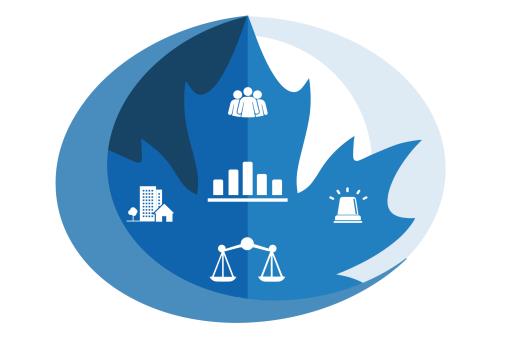Crime and Justice Statistics
Follow:
Sign up to My StatCan to get updates in real-time.
Features
Key indicators
Selected geographical area: ~ ' ' ~ Canada ~ ''; ?>
-
80.52.1%
 (annual change)
(annual change) -
5,8432.5%
 (annual change)
(annual change)
More key indicators
Selected geographical area: ~ ' ' ~ Canada ~ ''; ?>
-
99.50.4%
 (annual change)
(annual change) -
2,89812.7%
 (annual change)
(annual change) -
73.53.1%
 (annual change)
(annual change) -
778
-
1.94-14.5%
 (annual change)
(annual change)
Geospatial explorer

The Canadian Statistical Geospatial Explorer Hub empowers users to discover Statistics Canada's geo‑enabled data down to the smallest level of detail available, the dissemination area
Of interest
- Police-reported crime statistics in Canada, 2023, data tables
- Juristat
- Police-Reported Indigenous and Racialized Identity Statistics via the Uniform Crime Reporting Survey
- Cannabis Stats Hub
- Overview of the Adult Criminal Justice System
- State of the Criminal Justice System
- The Chief Statistician's Top Ten for 2022
- Report and Draft Recommendations: Engagement on Corrections Disaggregated Data and Analysis Strategy
Police-reported Indigenous and Racialized Identity Data collection initiative
In response to increasing demands for better disaggregated data to shed light on people's diverse experiences, Statistics Canada and the Canadian Association of Chiefs of Police (CACP) are collaborating on an initiative to collect data on the Indigenous and racialized identity of all victims and accused persons involved in criminal incidents, through the Uniform Crime Reporting (UCR) Survey.
Status of key milestones:
Phase 1: Consultative engagements
2020 to 2022
Status: Completed
More on Phase 1...
- Stakeholder consultations
- Engagements with Indigenous and racialized community organizations, police services, academics and other partners
- Report and draft recommendations published on Statistics Canada website
Phase 2: Operationalization and UCR technical changes
2022 to 2023
Status: Ongoing
More on Phase 2...
- Debriefs and Phase II engagements with Indigenous and racialized community organizations, police services, police associations, academics, RMS vendors and other partners
- Launch of a CACP special purpose committee
- Identification of first adopting and/or pilot jurisdictions
- Training development begins
- UCR system updates at Statistics Canada
- Progress update and next steps report published on Statistics Canada website
- Discuss and draft data analysis and dissemination guidelines
Phase 3: Implementation
2024
Status: Upcoming
More on Phase 3...
- UCR 2.5 launch
- Training delivery
- Release of guidelines for data collection and reporting
Phase 4: Data management and analysis guidelines
2024 and ongoing
Status: Upcoming
More on Phase 4...
- Vetting and disclosure rules, and data stewardship planning
- Finalize and publish data analysis, release and review guidelines
- Develop analytical plan
Related reports:
- Phase 1 report: Report and Draft recommendations
- Phase 2 report: Progress Update and Next Steps
Canadian Centre for Justice and Community Safety Statistics

Since 1981, the Federal, Provincial and Territorial Deputy Ministers Responsible for Justice and Public Safety in Canada have been working together, along with the Chief Statistician of Canada, in an enterprise known as the National Justice Statistics Initiative (NJSI). The mandate of the NJSI is to provide information to the justice community and the public on the nature and extent of crime and victimization and the administration of criminal and civil justice in Canada. As the operational arm of the NJSI, the Canadian Centre for Justice and Community Safety Statistics (CCJCSS), a division of Statistics Canada, is responsible for the development, collection, integration and analysis of data that reflect trends in Canada and on the development of national- and jurisdictional-level indicators.

 Correctional services
Correctional services Courts
Courts Crimes and offences
Crimes and offences Victimization
Victimization




